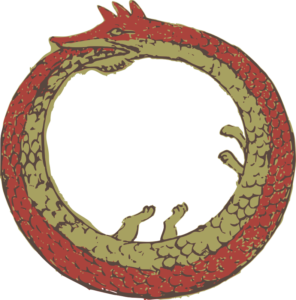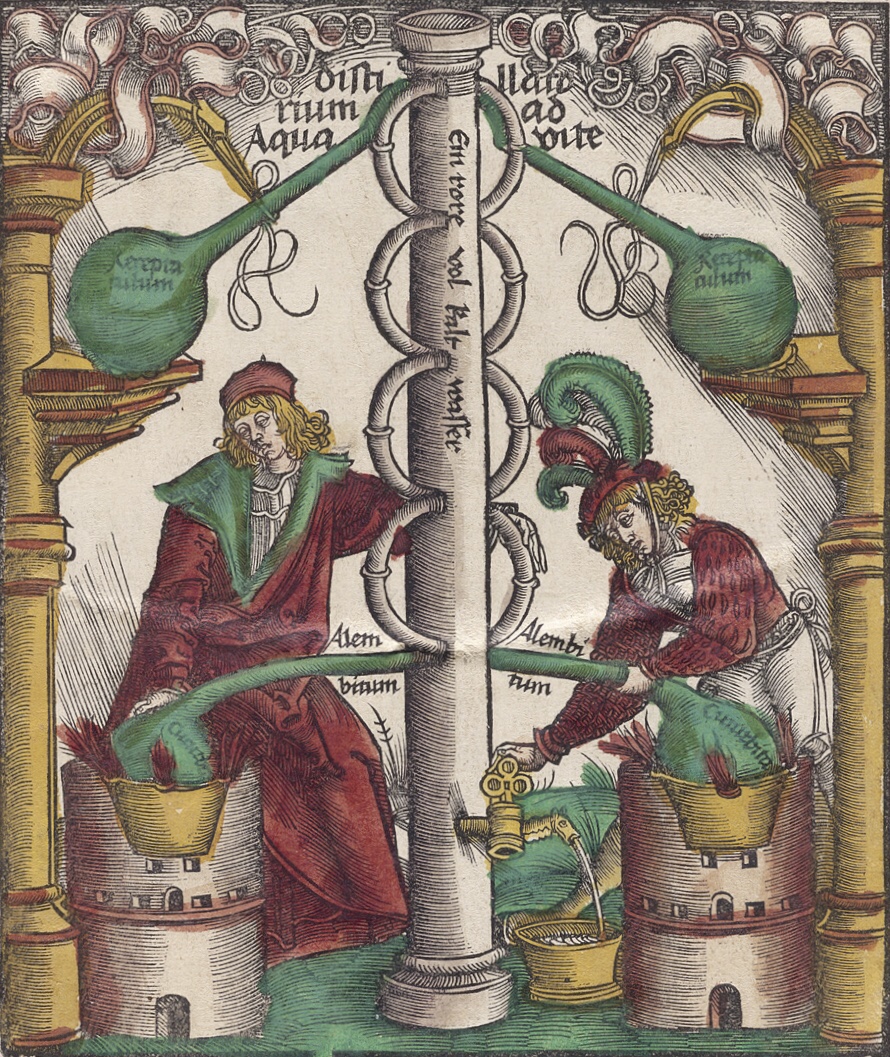
Like so many staples of western occultism, alchemy has its origins in the multicultural world of Hellenized Egypt around the first century. Of course, this is only as far back as we can trace it based on written evidence. Humans had been working with metal and chemicals for thousands of years prior, creating alloys and manufacturing artificially created compounds. Despite not understanding the scientific functions that produced the results, ancient and premodern artisans were adept at this early metallurgy and chemistry. Not only were they interested in the functional aspects of the craft, but as early as 300 AD the writings of Zosimos of Panopolis describe and underlying theoretical framework with which these early “alchemists” hoped to manipulate physical materials.
While the terminology and theories described by Zosimos, such as dividing the nature of metals into a “spirit” and “body”, would characterize them as “magical” or “occult” to modern readers, alchemy at this point in history was much closer to chemistry than any metaphysical process. Zosimos is described by the historian of science Lawrence M. Principie as a “chrysopoeian“, meaning “one who makes gold”, and this more accurately reflects the goal of these early “alchemists”. Zosimos describes his work and experiments in a way that closely mirrors the core of the scientific method today; carefully thought out experiments, recording results, detailing all the materials including advanced equipment, and theories developed from direct observation. Since there was essentially no distinction between what people understood of the physical world and the divine, metaphysical forces were equally considered in the theories of how and why the results of the experiments appeared as they did. Before the Enlightenment, this convergence of science and the supernatural is well described as “natural philosophy”. Once western culture began to prioritize reason over religious authority in matters of the material world and humans’ place in it, previously conflated practices like alchemy and chemistry were more formally separated in discussion and practice. It is tempting to look to the past and apply such labels retroactively to authors and their intent. However, doing so is anachronistic and dulls the impact of the material. One could read early alchemical authors such as Zosimos as early chemists who should be praised for their advanced, scientific minds or as authors of allegorically veiled spiritual secrets. Both extreme views ignore elements of the contrary and are lesser for it. There is no reason that Zosimos can’t be respected for his scientific and spiritual endeavors in the context of when he lived. Alchemy, much like astrology, has at its core these two seemingly opposed components. The material nature of metals or the planets and their assigned metaphysical properties exist at opposite ends of a spectrum. Science is relegated to one far end (as it reasonably should be) but the esoteric view need not confine itself to the exact opposite. Later iterations of alchemy cast it in exclusively allegorical and spiritual realms, disparaging any connection to early practitioners who sought to craft gold from lead. Wise readers would do well to form their own conclusions about the nature of any work, practitioner and academic alike.
This next section will be a bit of divergence into a very generalized history for the purpose of context. If you’d like to skip it and continue on to just the topic of alchemy, you’re free to view or hide it as you wish:

So alchemy began in metallurgy and craftsmanship with the aim of transforming materials into silver and gold via processes that were the beginnings of modern chemistry. This knowledge has now migrated to the Islamic world where it develops further, both theoretically and practically, influenced by innumerable minds. Three things related to this period make it difficult to study: first is that the study of Islamic and Arabic manuscripts, authors, etc., has only really begun in earnest for a western audience in recent years, second is the propensity for authors to attribute their work to others (especially to the possibly fictitious Jabir ibn-Hayyan who ostensibly wrote over 3,000 books), and the appearance of the mysterious Emerald Tablet.
This first problem isn’t really a problem, more of an opportunity. With new translations, analyses, and commentary on Middle Eastern and Islamic work of this era becoming more prevalent in recent years, both critical academic and casual interest can flourish. As for the confusion caused by misattribution or intentional subterfuge, if not knowing all the answers bothers you then occult studies is going to continue to rub you the wrong way in general. The best we can do is continue to search, question, and discover. History will never give up all her secrets but the joy is in sussing out what answers we can. One of those secrets, which will likely never be fully revealed, is that of the Emerald Tablet, or the tabula smaragdina.
The farthest we can trace the Tablet’s origins is to roughly the eight century as part of an Arabic collection of works from a multitude or sources called the Book of the Secret of Creation. The text, despite its brevity, has played a large role in Hermetic thought and philosophy. It has also consistently frustrated alchemists since its appearance as they consider it a key to creating a “philosopher’s stone”, which had become one the primary aims of alchemy at this point. The full text is reproduced below, an English translation of Jabir ibn Hayyan’s Arabic version, from The Western Esoteric Traditions (full citation at the bottom of the page):
The “philosopher’s stone” has gone by many names and has taken many forms, both physical and immaterial. In early incarnations, it was a powder that allowed for the transmutation of base metals into gold and/or silver. It was also thought to either be, or able to produce, the “elixir of life”. This latter substance could heal any wound and/or gift the user with immortality. While the earliest incarnations of alchemy were not unfamiliar with the inclusion of medicine, the development of a sharper focus on its ability to produce elixirs, cure-alls, and even unending life may have come from cultural exchange with Asia, especially what are now China and India. These areas had their own conception of “alchemy” which also included transmutation of material into gold. The search for the “elixir of life”, however, was by and large the main goal of the practices in the east. Mercury played a large role, in both east and west, in the search for alchemical secrets as well as immortality. In an interesting confluence of practices and influence, the Arabic corpus of the aforementioned Jabir ibn-Hayam combined principles from Galenic medicine with alchemical theories of metals.

By the mid 13th century, the Arabic treatises and works had been adequately circulated in Medieval Europe to allow for Western development of the craft. It was not without its controversy, however. The most influential of philosophers, theologians, and artisans argued for and against the promises of alchemy. Many derided it as the work of charlatans who promised what they could never deliver. Others argued for its potential to genuinely manipulate nature and her materials. There was even discussion as to what exactly alchemy produced, whether it was true gold and silver or some lesser shadow of the desired metal. This confusion likely surfaced from the methods that involved plating base materials with precious metals or chemical manipulation that made them appear like gold and silver, even if they didn’t react to heat or other tests like the true metals. While these developments encouraged alchemists that their end goal may be possible, it unfortunately appealed to forgers and counterfeiters of the time. Bans against the practice of alchemy was more of an economic concern than a superstitious one.
As the art persisted into the Renaissance era, it was so diverse and widely practiced that different schools or subdivisions thrived and grew. A sort of “practical alchemy” produced dyes and chemicals used in art and construction. Medical alchemy focused on salves and cure-alls. Of course, a number of alchemists still sought out the fabled technique that would produce gold. The last most prominent category had its roots in the earliest forms of alchemy, that of spiritual meaning and allegory, but grew in importance (perhaps due to so many centuries of failure to produce physical gold or philosopher’s stone).
By the mid 1700s, the idea of alchemy being able to create gold had been all but abandoned. The medical and practical aspects eventually dovetailed into modern medicine and chemistry respectively. The Enlightenment finally divided alchemy, sorting the wheat from the chaff in the spirit of Reason, into either chemistry or superstition. Anyone who entertained alchemy’s promises of transmutation or eternal life had to do so in secret to avoid ridicule. And yet, like so many other occult practices, it did indeed persist until rediscovered and reimagined.
For post-Enlightenment alchemy, the focus shifted to the spiritual interpretation that had always simmered within its currents. Psychoanalysts Herbert Silberer and Carl Jung were particularly interested in alchemy’s utility for exploring the human psyche and the subconscious world of the mind. For more information on this development, go to the page on Alchemy and Psychoanalysis.

Alchemical Texts and Manuscripts
Just a small sample for now that I hope to add to later:
Middle Eastern Alchemical Texts:
https://www.nlm.nih.gov/hmd/arabic/alchemy_tb.html#top
Brunschwig’s Liber de Arte Distillande – German, 16th century printed book
Image Gallery at the NLM website

Theatrum Chemicum (Latin, 1652)
Digitized version from the Library of Congress’ collection of rare books
Bibliotheca Chemica Curiosa (Italian, 1702)
Digitized version from the Library of Congress’ collection of rare books
![]()
Bibliography
Goodrick-Clarke, Nicholas. The Western Esoteric Traditions: A Historical Introduction. Oxford University Press, 2008.
Jung, C. G. Collected Works of C.G. Jung, Volume 12: Psychology and Alchemy. Princeton University Press, 1968.
—-. Collected Works of C.G. Jung, Volume 13: Alchemical Studies. Edited and translated by Gerhard Adler and R. F. C. Hull, Princeton University Press, 1967.
—-. Collected Works of C.G. Jung, Volume 14: Mysterium Coniunctionis. Edited and translated by Gerhard Adler and R. F. C. Hull, Princeton University Press, 1970.
Partridge, Christopher, editor. The Occult World. Routledge, 2016.
Principie, Lawrence M., The Secrets of Alchemy. The University of Chicago Press, 2013.
Shumaker, Wayne. The Occult Sciences in the Renaissance: A Study in Intellectual Patterns. University of California Press, 1979.
Silberer, Herbert. Alchemy & Psychoanalysis [Problems of Mysticism and Its Symbolism]. The Lost Library, 2016.


